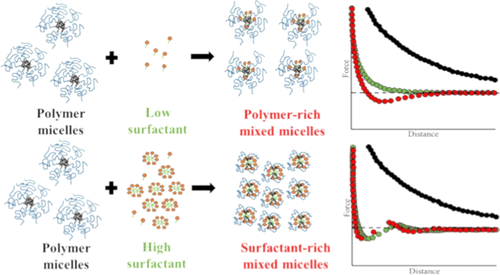Our official English website, www.x-mol.net, welcomes your feedback! (Note: you will need to create a separate account there.)
Depletion Forces Induced by Mixed Micelles of Nonionic Block Copolymers and Anionic Surfactants.
Langmuir ( IF 3.9 ) Pub Date : 2020-08-22 , DOI: 10.1021/acs.langmuir.0c01574 Bhagyashree J Lele 1 , Robert D Tilton 1, 2
Langmuir ( IF 3.9 ) Pub Date : 2020-08-22 , DOI: 10.1021/acs.langmuir.0c01574 Bhagyashree J Lele 1 , Robert D Tilton 1, 2
Affiliation

|
Depletion forces were measured between a silica sphere and a silica plate in solutions containing nonionic Pluronic P123 poly(ethylene oxide-b-propylene oxide-b-ethylene oxide) triblock copolymers and anionic sodium dodecyl sulfate (SDS) surfactants using colloidal probe atomic force microscopy. Prior research established synergistic depletion force enhancement in solutions containing SDS and unimeric Pluronic F108 block copolymers via formation of large pseudo-polyelectrolyte complexes. The current work addresses a more complex system where the polymer is above its critical micelle concentration, and surfactant binding alters not only the size and charge of the micelles but also the number of polymers per micelle. Force profiles were measured in 10 000 ppm P123 (1 wt %, corresponding to 1.72 mM based on average molar mass) solutions containing SDS at concentrations up to 64 mM and compared to micellar P123 solutions and to P123-free SDS solutions. Whereas force profiles in the SDS-free micellar P123 solutions were purely repulsive, P123/SDS complexation produced synergistic depletion force enhancement for SDS concentrations between 2 and 32 mM. The synergism that occurred within a finite SDS concentration range was explained by comparing the hydrodynamic size, molar mass, charge, and concentration of depletants in P123/SDS mixtures and their respective single-component solutions obtained with the aid of dynamic light scattering, static light scattering, and dodecyl sulfate ion-selective electrode measurements. These measurements showed that complexation produced effects that would be mutually counteracting with respect to depletion forces: decreasing the mixed micelle hydrodynamic diameter relative to SDS-free P123 micelles would tend to weaken depletion forces, while adding charge and decreasing the aggregation number of polymers per micelle (thereby increasing the number concentration of micellar depletants) would tend to strengthen depletion forces.
中文翻译:

非离子型嵌段共聚物和阴离子表面活性剂混合胶束引起的耗尽力。
在包含非离子Pluronic P123聚(环氧乙烷-b-环氧丙烷-b)的溶液中测量二氧化硅球和二氧化硅板之间的耗尽力-环氧乙烷)三嵌段共聚物和阴离子十二烷基硫酸钠(SDS)表面活性剂使用胶体探针原子力显微镜。先前的研究通过形成大的假聚电解质络合物,在含有SDS和单体Pluronic F108嵌段共聚物的溶液中建立了协同耗竭力增强。当前的工作针对的是更复杂的系统,其中聚合物高于其临界胶束浓度,表面活性剂的结合不仅改变了胶束的大小和电荷,而且改变了每个胶束的聚合物数量。在含有浓度高达64 mM的SDS的10000 ppm P123(1 wt%,对应于平均摩尔质量的1.72 mM)溶液中测量力分布,并与胶束P123溶液和不含P123的SDS溶液进行比较。不含SDS的胶束P123溶液中的力分布是纯排斥性的,而P123 / SDS络合对于2至32 mM的SDS浓度产生协同消耗力增强。通过比较P123 / SDS混合物及其各自的单组分溶液中借助动态光散射,静态光获得的流体动力学尺寸,摩尔质量,电荷和贫化剂的浓度,解释了在有限的SDS浓度范围内发生的协同作用。散射和十二烷基硫酸盐离子选择电极的测量。这些测量结果表明,络合作用会产生与消耗力相互抵消的效果:相对于不含SDS的P123胶束,降低混合胶束的流体动力学直径会趋于减弱消耗力,
更新日期:2020-09-15
中文翻译:

非离子型嵌段共聚物和阴离子表面活性剂混合胶束引起的耗尽力。
在包含非离子Pluronic P123聚(环氧乙烷-b-环氧丙烷-b)的溶液中测量二氧化硅球和二氧化硅板之间的耗尽力-环氧乙烷)三嵌段共聚物和阴离子十二烷基硫酸钠(SDS)表面活性剂使用胶体探针原子力显微镜。先前的研究通过形成大的假聚电解质络合物,在含有SDS和单体Pluronic F108嵌段共聚物的溶液中建立了协同耗竭力增强。当前的工作针对的是更复杂的系统,其中聚合物高于其临界胶束浓度,表面活性剂的结合不仅改变了胶束的大小和电荷,而且改变了每个胶束的聚合物数量。在含有浓度高达64 mM的SDS的10000 ppm P123(1 wt%,对应于平均摩尔质量的1.72 mM)溶液中测量力分布,并与胶束P123溶液和不含P123的SDS溶液进行比较。不含SDS的胶束P123溶液中的力分布是纯排斥性的,而P123 / SDS络合对于2至32 mM的SDS浓度产生协同消耗力增强。通过比较P123 / SDS混合物及其各自的单组分溶液中借助动态光散射,静态光获得的流体动力学尺寸,摩尔质量,电荷和贫化剂的浓度,解释了在有限的SDS浓度范围内发生的协同作用。散射和十二烷基硫酸盐离子选择电极的测量。这些测量结果表明,络合作用会产生与消耗力相互抵消的效果:相对于不含SDS的P123胶束,降低混合胶束的流体动力学直径会趋于减弱消耗力,



























 京公网安备 11010802027423号
京公网安备 11010802027423号